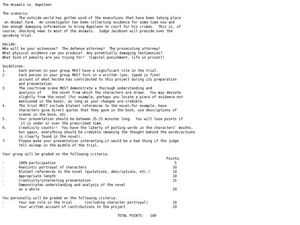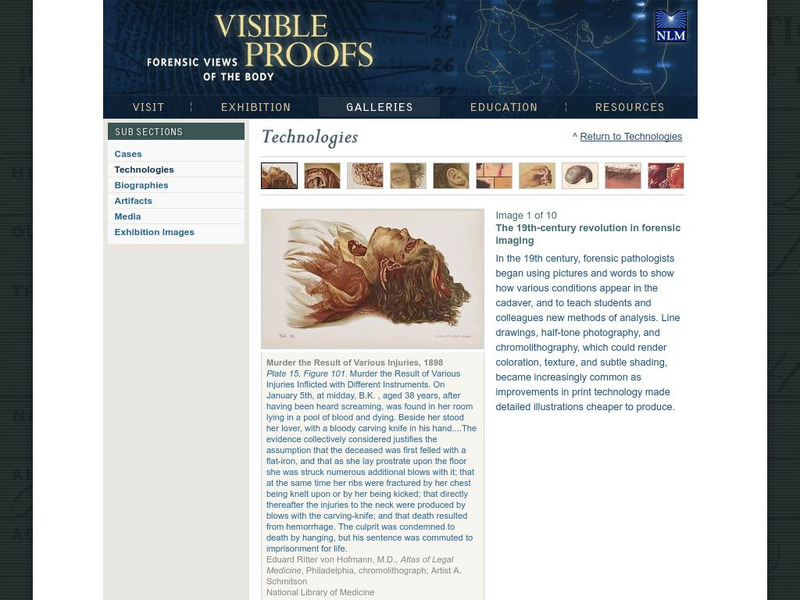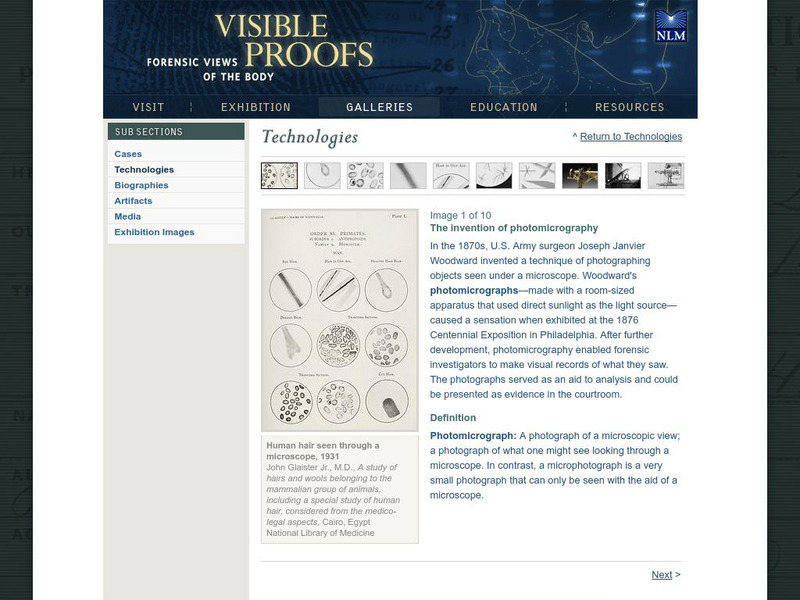Curated OER
The Animals vs. Napoleon
In this literature analysis worksheet, students read Animal Farm and complete a trial activity project based on the characters of the animals vs. Napoleon.
Curated OER
Body Tracing
Students pair up and trace each other's body outlines on roll paper with marker. Once complete, students fill in the inside of the figures with texture- lines, forms, shapes, colors, etc. Students cut out the figure.
Curated OER
Trace Evidence
In this trace evidence worksheet, students use the websites on the forensic science page of the kid zone at http://sciencespot.net/ to complete the fill in the blank questions on the worksheet.
Curated OER
Solving Mysteries Using Paper Chromotagraphy
Students solve the mystery of the kidnapped teacher by analyzing a ransom note using paper chromatography. They carefully prepare ink samples from the note to known ink samples to determine the kidnapper.
Curated OER
Sentence Completion 2: Low-Advanced SAT Level
Contemplating a test-prep unit? A reading comprehension strategies session? Check out this sentence completion worksheet. After test takers try their hand at a sentence completion exercise, they can use the detailed answers and...
Curated OER
Lewis and Clark in Columbia River Country
Learners interpret historical evidence presented in primary and secondary resources. In this research skills lesson, students research the death of Meriwether Lewis using forensic evidence presented in primary...
Curated OER
Blood, I Presume?
Students explain the value of blood in trials. In this DNA lesson students work together to collect and share information and ideas that they come up with after learning how to distinguish blood from other stains.
Curated OER
Science Detectives
Fifth graders examine the differences between chemical and physical changes. As a class, they are read a scenerio and determine whether it was deliberate act or not. In groups, they observe the changes of an alka-seltzer tablet and...
Curated OER
Density of Glass Fragments
Students explore how the density of an object is determined and determine what a "physical property" is. They demonstrate how science can be applied to police work.
Curated OER
Dig Magazine Archeology Quiz #106
In this Dig Magazine archeology quiz, students answer 12 multiple choice questions complementing the October 2009 issue. Page contains answer and additional resources link.
Curated OER
DNA Fingerprinting
Students experiment with chromatography as a technique which is similar to electrophoresis that scientists use to identify DNA samples.
Other
Crime Scene Investigation: Protecting the Crime Scene
This brief but informative site examines how a crime scene should be protected with emphasis on the role of the first officer(s) to arrive. Points are made about the arrival of additional personnel, eating and drinking at the crime...
Other
Crime Scene Investigator: Searching and Examining a Major Case Crime Scene
An engrossing explanation of the appropriate behavior needed at a major crime scene. What should be done with the body? How is photography handled? What about fingerprinting? How are curious onlookers dealt with? The answers to the...
Other
Crime Scene Investigation: Proper Tagging and Labeling of Evidence
What is the purpose of tagging and labeling items of evidence? What information belongs on the tag? These questions are answered in this concise but competent site.
Natural History Museum
Natural History Museum: On Maggots and Murders: Forensic Entomology [Pdf]
Five-page article explains how forensic scientists, when investigating crimes, analyze maggots and blowflies to determine approximate times of death.
National Institutes of Health
National Library of Medicine: The 19th Century Revolution in Forensic Imaging
In the 19th century, forensic pathologists began to use words and pictures to describe cadavers and to teach using cadavers in the classroom. See a number of interesting photos of various crime scenes on this interesting site.
National Health Museum
Access Excellence: Dna Detectives
A hands-on activity from Access Excellence for advanced biology classes. Students are given a crime scenario and three suspects. Their mission is to determine 'Who Dunnit?' by obtaining and analyzing DNA samples. Requires extensive...
PBS
Pbs: What Jennifer Saw
How can eyewitness identification go wrong? What role can DNA play in protecting the innocent? This interesting site answers these questions and gets the opinions of several DNA experts on this fascinating subject.
University of Missouri
Famous Trials: West Memphis Three Trials (1994)
On a warm sunny May day three eight-year-old boys set off on a bike ride around their hometown of West Memphis, Arkansas. The next afternoon, their bruised and mutilated hog-tied naked bodies were pulled from a stream, setting off an...
National Institutes of Health
National Library of Medicine: The Invention of Photomicrography
The technique of photographing objects observed under a microscope is discussed in this succinct site. Various pictures taken under a microscope are displayed on this site as well.
National Institutes of Health
National Library of Medicine: Reading Gunshot Patterns
Various pictures of parts of the human anatomy showing gun shot trauma are found on this interesting site. .
PBS
Pbs: Interview With Bennett Gershman, Former Prosecutor
Why does the criminal justice system resist reopening cases based on new DNA evidence? This former prosecutor sheds light on the answer in this informative interview.
National Institutes of Health
National Library of Medicine: Spectral Detection
This concise site provides a brief discussion of the invention of the first work spectroscopes and their impact on forensic science.

















